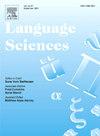与性别相关的中文网络新词中贬义社会词tái的进一步语义变化
IF 1.1
2区 文学
Q2 EDUCATION & EDUCATIONAL RESEARCH
引用次数: 0
摘要
网络新词为草根网民提供了话语空间。本研究探讨了台湾网络论坛中流行的一对性别标签:táinán "台男 "和 táinǚ "台女"。基于在线数据语料库的定量关键词分析表明,táinán 和 táinǚ 是贬义标签。对关键词在语境中的定性话语分析分别呈现了与 táinán 和 táinǚ 相关的性别刻板印象。一项问卷调查也证明了人们对 táinán 和 táinǚ 的负面态度。共同语素 tái 继承了与本地性有关的意识形态,并与有关理想男性和理想女性的性别意识形态相互作用,它已成为有利的外来性和不利的本地性之间意识形态对比的指标。本研究为当前在社会语境中研究汉语形态模式的文献做出了贡献。此外,本研究还提供了证据,证明社会意义的变化也遵循其他语义变化的主导轨迹。本文章由计算机程序翻译,如有差异,请以英文原文为准。
Further semantic change of the derogatory sociomorpheme tái in Chinese gender-related Internet neologisms
Internet neologisms provide discursive spaces for grassroots netizens. This study examines a pair of gendered labels gaining popularity in Taiwanese online forums: táinán ‘Tai-man’ and táinǚ ‘Tai-woman’. The quantitative keyword analysis based on a corpus of online data suggests that táinán and táinǚ are pejorative labels. The qualitative discourse analysis of the keywords in context presents gender stereotypes associated with táinán and táinǚ, respectively. Converging evidence for the negative attitudes toward táinán and táinǚ is obtained in a questionnaire survey. The shared morpheme tái inherits localness-related ideologies and interacts with gender ideologies concerning ideal manhood and womanhood, and it has come to index an ideological contrast between favorable foreignness and unfavorable localness. This study contributes to the current literature on Chinese morphological patterns studied in social contexts. Moreover, this study presents evidence that changes in social meanings also follow the dominant trajectories of other semantic changes.
求助全文
通过发布文献求助,成功后即可免费获取论文全文。
去求助
来源期刊

Language Sciences
Multiple-
CiteScore
2.90
自引率
0.00%
发文量
38
期刊介绍:
Language Sciences is a forum for debate, conducted so as to be of interest to the widest possible audience, on conceptual and theoretical issues in the various branches of general linguistics. The journal is also concerned with bringing to linguists attention current thinking about language within disciplines other than linguistics itself; relevant contributions from anthropologists, philosophers, psychologists and sociologists, among others, will be warmly received. In addition, the Editor is particularly keen to encourage the submission of essays on topics in the history and philosophy of language studies, and review articles discussing the import of significant recent works on language and linguistics.
 求助内容:
求助内容: 应助结果提醒方式:
应助结果提醒方式:


